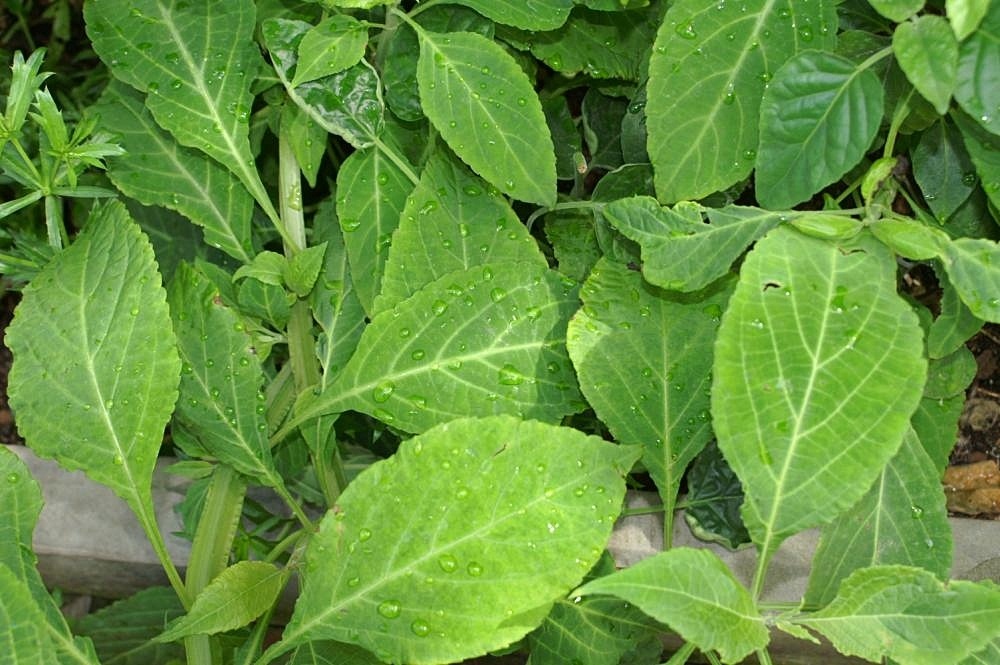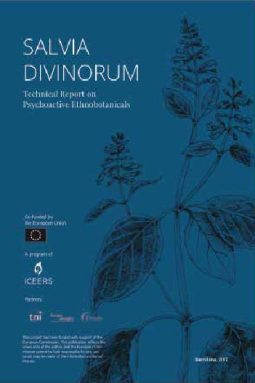Basic info
Salvia divinorum is a perennial plant native to the Mazatec areas of the Sierra Madre Oriental Mountains of Mexico. Its habitat is tropical forests, where it grows between 300 and 800 meters above sea level. It belongs to the lamiaceae family, and is mainly reproduced by cuttings since it rarely produces seeds.
It is known by different names: Ska Pastora, Pastora leaves, Maria Pastora leaves, or simply Salvia. It has been used by the Mazatec people for purposes of divination, as well as to treat various diseases such as anemia, rheumatism, headache, stomach swelling and diarrhea.
Salvia divinorum contains a potent psychoactive substance called salvinorin A that produces psychedelic and dissociative effects in very low doses, varying in duration depending on the route of administration, usually lasting between fifteen minutes and two hours. Salvinorin A is the most potent natural psychoactive substance known.
Salvia divinorum is used either orally, chewed, or smoked in the form of extracts.
Origin/History
The use of Ska Pastora is associated with the use of psilocybin mushrooms in Mazatec cults. It is unknown whether Salvia divinorum was used in the pre-Hispanic era, although some authors have hypothesized that the Aztecs may have used it and called it “Pipiltzintzintli”, but this speculation has its detractors and other plants like Cannabis and Rivea corymbosa (Ololihuiqui) could also be candidates for the Aztecan “Pipiltzintzintli”. In addition to shamanic, divinatory and magico-religious uses, Salvia divinorum has also been used for its medicinal properties.
Ska Pastora has been used in divination and healing rituals, similar to psilocybin mushrooms. Maria Sabina told Wasson and Hofmann (the discoverers of its Mazatec usage) that Salvia divinorum was used in times when there was a shortage of mushrooms. Some sources that have done later fieldwork point out that the use of S. divinorum may be more widespread than originally believed, even in times when mushrooms were abundant.
Rituals traditionally take place at night, in silent darkness. The leaves of the plant are chewed making a kind of cylinder with them. Participants chew the leaves in pairs, and the juice produced is not swallowed but kept in the mouth to be absorbed by the mucous membranes. Leander Valdés published his experiences on the current use of Salvia divinorum among the Mazatec people and included descriptions of the rituals as well as the effects of Salvia.
Once the effects begin, people lie down and remain quiet and silent. Visions often appear in this state. The Salvia ritual usually lasts less than two hours.
Chemical composition and dosage
The leaves of Salvia divinorum contain two diterpenes called salvinorin A and salvinorin B (also known as divinorin A and divinorin B). They also contain other substances that are not clearly identified.
Salvinorin A is the most potent natural psychedelic substance known. It is about 10 times more potent than psilocybin. Its chemical formula is C23H28O8 and it does not contain nitrogen, so it is not an alkaloid. At the pharmacological level it acts as a selective agonist for kappa opioid receptors, which differentiates it from other psychedelic compounds that act mainly on the serotonergic system, specifically binding to the 5HT2A receptors. Salvinorin A is therefore quite an unusual compound.
Doses of salvinorin A that produce psychoactive effects start at 150 micrograms (or millionths of a gram). Common doses are between 150 and 500 micrograms.
Dried S. divinorum can be found on the market, although its availability in the form of extracts is more common. These extracts are more potent than dried leaves, so a much smaller amount is required to achieve psychoactive effects. Fresh leaves are usually only found in places where S. divinorum is grown and are not usually available in other markets.
The traditional route of administration is usually the chewing of fresh or dried leaves, as well as the ingestion of leaf infusions. In current contexts in the western world, the most common route of administration is the smoking of extracts.
An approximate summary of the usual doses is as follows:
Smoked or vaporized route. Dosage of leaves
- Low dose: 0.25 grams
- Average dose: 0.5 grams
- High dose: 0.75 grams
Smoked or vaporized route. Dosage of 5x extract
- Low dose: 0.05 – 0.1 g
- Average dose: 0.08 – 0.15 g
- High dose: 0.01 – 0.025
Smoked or vaporized route. Dosage of Pure Salvinorin A
- Low dose: 75 – 100 μg (dose in micrograms, 1000 micrograms, ug = 1 milligram, mg)
- Average dose: 200 – 400 ug
- High dose: 400 – 500 ug
Sublingual/chewed route. Dosage of leaves
- Low dose: 10 g of fresh leaves / 2 g of dried leaves
- Average dose: 30 g of fresh leaves / 6 g of dry leaves
- High dose: 50 g of fresh leaves / 10 g of dried leaves
Oral route: infusion of crushed leaves (in pairs of leaves, traditional use)
- Low dose: less than 20 pairs (40 leaves)
- Average dose: from 20 to 60 pairs
- High dose: 60 to 80 pairs
Effects
The effects of S. divinorum vary greatly depending on the dose and, above all, on the way it is administered.
Some common effects are intense changes in perception and mood, as well as somatic sensations (pressure in certain areas of the body, applied force on the body, floating, body warmth) the sensation of merging with objects in the environment, changes in perceptions of spatial and temporal dimensions, as well as deep dissociative states, geometric visions or landscapes of a dream-like nature and extra-corporeal experiences.
The positive effects that some users report include: increased aesthetic appreciation of the environment, feeling calm, synesthesia, visions, feelings of insight and spiritual experiences, among others.
Negative or unwanted effects include: loss of control over the experience, difficulty in integrating experiences, panic attacks, fear, terror, agitation or loss of motor control, dizziness, paranoia, temporary loss of the ability to communicate and amnesia. These types of negative effects are more easily produced with potent extracts, occurring less frequently when the leaf is chewed.
The effects when the leaves are chewed or infused usually appear within ten minutes, and are maintained for a further forty-five minutes. There are reports of people claiming to have experienced effects hours after chewing and that the total duration was over four hours. However, the doses used in these cases usually vary from the five pairs of leaves (a non-psychotropic dose, traditionally used to treat anemia, regulate excretory functions and stomach swelling) up to fifty pairs.
The chewed or infused leaves produce a smoother effect, including visions with closed eyes. It is considered necessary to be in silent darkness in order to appreciate the intensity of the experience, as it may be difficult to perceive the effects otherwise.
When the plant is consumed by smoking or inhaling the vapors the effects are established much faster and the intensity is much greater. The experience begins within seconds of inhalation, its peak is sustained for 2-20 minutes and usually lasts for about 30 minutes, with residual effects up to one hour. High doses can produce strange effects, such as the sensation of a “doubling” of space-time, radical changes in perspective from which reality is experienced, loss of consciousness of the individual self or ”I”, forgetting that a substance has been consumed, sensations of energies in movement, pressure, the sensation of entering other dimensions, profound alterations to the perception of time… Experiences can be pleasant, but also frightening given their intensity and strangeness. The frequency of difficult, confusing or frightening experiences seems to be relatively high among users, and many people decide not to reuse Salvia after a single experience. Some users also report that the use of Salvia occasionally causes a strong feeling of anxiety and paranoia.
Occasionally people will move about spontaneously during the experience, and even get up and walk without being aware of it. This implies the risk of falls and accidents.
Legal status
Neither Salvia divinorum nor salvinorin A are included on the lists of United Nations conventions on drugs.
However, some countries have included S. divinorum and salvinorin A in their lists of controlled substances. These countries are: Australia, Japan and some states of the United States; and in Europe: Italy, Lithuania, Latvia, Sweden, Romania, Belgium and Denmark.
In countries such as Norway, Finland, and Estonia, practices with the plant are regulated under drug legislation. In others — such as Spain, Poland, Germany, and Croatia — certain activities with the plant are subject to regulation without it being fully prohibited.
Health and risk reduction
The potency of the leaves is difficult to gauge, and extracts can vary widely depending on the supplier. Therefore dosing can be complicated, and there is a risk of overdose, in particular using smoked extracts.
It is important to calculate the dose well using a precision scale, and be cautious with the amounts used. The use of Salvia divinorum produces a tolerance, so people who use it frequently or on successive occasions need to increase the dose to experience effects.
An experience with S. divinorum can be frightening in some cases and involve situations of fear, panic and extreme states of confusion. At high doses it is common to be unaware of the environment, or to forget having smoked Salvia. There is a clear danger of getting up during the experience and having an accident. It is highly recommended to have a sober caretaker present the entire time during experiences with S. divinorum.
The context or setting is also important as some users report difficult experiences due to the environment itself. Safe, calm environments, with little stimuli, away from crowds, free of dangerous objects or obstacles and with a sober caretaker will reduce the risks of accidents and negative experiences.
Prevalence of use
There is little conclusive information about the prevalence of S. divinorum use in different European countries. There are some studies that have documented data on Salvia use in different countries and contexts. In general Salvia is a little used substance, and among those who have used it the frequency of its use is also very limited.
Studies of the United States population indicate that Salvia is mainly used by people in the 18-25 age group, principally males who are active consumers of other psychoactive substances, predominantly stimulants and psychedelics. According to these studies 1.3% of the respondents had used Salvia in their lifetime in 2008.
According to the EMCDDA, about 3.2% of those who regularly go to electronic music dance clubs have used S. divinorum on some occasion in the last month, and 29.2% have used it in their lifetime. These results cannot be extrapolated either to the general population or to other dance club users, due to the bias of online surveys.
According to EMCDDA data from 2014, 0.4% of adolescents in Spain between the ages of 14 and 18 have tried Salvia in the last 12 months and 0.6% has done so in their lifetime.
The Global Drug Survey collects data for 2017, and 6.1% of those surveyed claim to have used Salvia at some point in their lifetime. This is an online questionnaire, which people access and answer voluntarily, so there may be a bias in the type of people who have filled out the form. Salvia appears in thirteenth position of the most consumed drugs, ahead of crack, methylphenidate, methamphetamine, opium, DMT and other substances.
In any case the use of S. divinorum seems to be clearly experimental, and it is not used socially, recreationally or as a substance for partying. Also, the use of Salvia divinorum seems to have a low continuation rate, and about half of people who consume it once have no intention of repeating the experience.
Categories:
PSYCHEPLANTS
, Others
, Salvia divinorum
Tags:
psycheplants
, Salvia divinorum
, information
, México


